Category: Agriculture
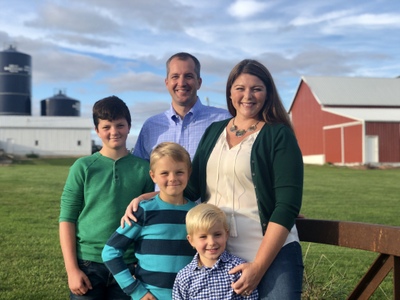
We Need FFA: Iowa Ag Secretary Mike Naig Reflects on His FFA Experiences
When you look at his formative years, my friend Mike Naig shouldn’t be where he is today, serving as Iowa’s Secretary of Agriculture. Even for him, it’s hard to shake memories of the Farm Crisis.
“As a child of the 1980s, I knew my parents didn’t want us to go through the same hardships they did,” said Naig, 40, the third of four Naig children who grew up on their family’s farm near Cylinder in northwest Iowa. “There was this mentality of ‘go do something other than farming,’ so my siblings and I were going to college and pursue careers off the farm.”
Naig considered studying veterinary medicine or a major related to human health. Yet there was something that planted a seed back then in Palo Alto County, something that would take root and shape Naig’s future in ways he could never imagine. That transformative experience was FFA.
“I never predicted I’d serve in a role like this, but I’m grateful for the life skills and ag knowledge I learned in FFA,” said Naig, who is one of Iowa’s most high-profile champions of FFA, especially during National FFA Week from February 16-23, 2019. “We need FFA.”
Naig speaks from experience. Before serving as Iowa’s Secretary of Agriculture, this Buena Vista University graduate worked in agribusiness for more than 13 years, serving in public policy roles for state and national trade associations and in private industry. He served as the Iowa Deputy Secretary of Agriculture under Bill Northey starting in September 2013.
When Northey joined the U.S. Department of Agriculture (USDA), Iowa Governor Kim Reynolds appointed Naig to succeed Northey as Iowa Secretary of Agriculture on March 5, 2018. Naig was elected Secretary of Agriculture in November 2018. Here’s his story:
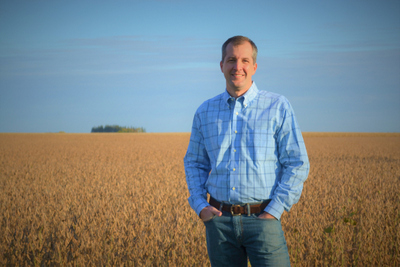
Iowa Secretary of Agriculture Mike Naig
Q: How did your leadership journey begin?
A: Before I joined FFA, I was heavily involved in 4-H. The first meeting I ever chaired was at my local Independence Boosters 4-H Club. I stayed involved in 4-H through high school and served in all the officer roles. I also served on the 4-H Youth County Council in Palo Alto County. During high school, I went on a leadership trip to Washington, D.C. This helped spark my interest in government and politics.
Q: What role did FFA play in your years at Emmetsburg High School?
A: While I was involved with the student council and served as student body president in high school, I was really into soil judging with FFA. Before I graduated from high school in 1996, our soil judging team made it to state and then to the national competition in Oklahoma. All this fit well with my interest in science, soil quality and soil health. Those of us in FFA were fortunate to have a strong FFA chapter, a great advisor, Jerry Strand, and a supportive community. Although I didn’t know it back then, all this would provide a strong background for my career when I started working on soil and water quality policy issues.
Q: What lessons did you learn from your FFA experiences?
A: FFA teaches you that preparation pays off. The supervised agricultural experience (SAE) challenges you to come up with a project and see it through. This requires you to get organized, plan ahead and think strategically. For many kids, this is one of the first big tastes of responsibility they get. You also learn teamwork, since you have to work together to get things done. Competition is also important in FFA. You learn to put your best effort forward and win with grace. If you come up short, you learn from your mistakes and are encouraged to do better next time.
Q: How can FFA help Iowa meet the challenges of the twenty-first century?
A: FFA does a great job of helping kids learn about the rewarding, ag-related careers that are available in a variety of disciplines right here in Iowa. FFA also does an outstanding job of developing the next generation of ag leaders. This is important, because I see “volunteer fatigue” in many communities. There are plenty of opportunities to serve, including local churches, school boards, county Farm Bureau boards, co-op boards and hospital boards, but it can be hard to replace dedicated board members and volunteers who have served so well for many years. We have significant needs in our rural communities across the state, and we’ll need leaders like those in FFA today to step up and fill these important roles going forward.
Q: What excites you about the future of FFA and Iowa?
A: While these are challenging times in agriculture, there’s always reason for hope. Protein demand worldwide is growing, along with demand for bio-based fuels. Technology continues to advance and create new opportunities. There’s so much we have yet to discover in agriculture, which is exciting!
Iowa is at the epicenter of all this. We have something very special here, and it’s not just our rich soil. It’s our people. Rural Iowa can thrive when it’s guided by lifelong learners who are focused on continuous improvement to protect our precious natural resources and expand economic opportunities. FFA members will be part of this future, guided by the knowledge that feeding people is a noble profession. FFA has a strong record of developing leaders. It’s essential we keep FFA and ag education strong in our schools.
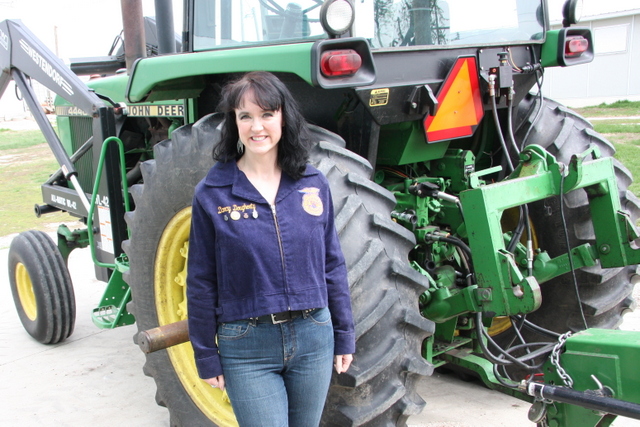
Forever proud to wear the iconic FFA blue jacket!
A note from Darcy:
I appreciate Mike’s comments about the importance of FFA and ag education for this story, which first appeared in Farm News. FFA played a critical role in helping me find my career, but boy, was it a strange, wacky, wonderful journey. Read the whole crazy story here.
Want more?
Thanks for stopping by. I invite you to read more of my blog posts if you value intriguing Iowa stories and history, along with Iowa food, agriculture updates, recipes and tips to make you a better communicator.
If you like what you see and want to be notified when I post new stories, be sure to click on the “subscribe to blog updates/newsletter” button at the top of this page, or click here. Feel free to share this with friends and colleagues who might be interested, too.
Also, if you or someone you know could use my writing services (I’m not only Iowa’s storyteller, but a professionally-trained journalist with 20 years of experience), let’s talk. I work with businesses and organizations within Iowa and across the country to unleash the power of great storytelling to define their brand and connect with their audience through clear, compelling blog posts, articles, news releases, feature stories, newsletter articles, social media, video scripts, and photography. Learn more at www.darcymaulsby.com, or e-mail me at yettergirl@yahoo.com.
If you’re hungry for more stories of Iowa history, check out my top-selling “Culinary History of Iowa: Sweet Corn, Pork Tenderloins, Maid-Rites and More” book from The History Press. Also take a look at my latest book, “Dallas County,” and my Calhoun County” book from Arcadia Publishing. Both are filled with vintage photos and compelling stories that showcase he history of small-town and rural Iowa. Order your signed copies today! Iowa postcards are available in my online store, too.
Let’s stay in touch. I’m at darcy@darcymaulsby.com, and yettergirl@yahoo.com.
Talk to you soon!
Darcy
@Copyright 2019 Darcy Maulsby & Co. Blog posts may only be reprinted with permission from Darcy Maulsby.
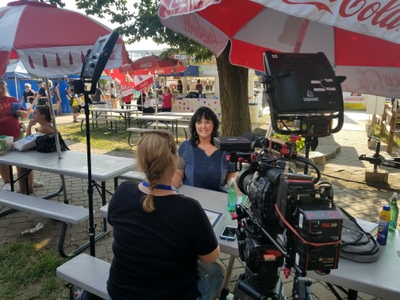
What To Do When the Travel Channel Calls
Just how far can things go when you tell agriculture’s story? Turns out your message might just resonate with a national audience.
For me, it all started with a simple email on June 15. I was checking inbox that morning when I saw a note with the subject line “Bizarre Foods: Delicious Destinations– Researching Iowa.”
Could this be THE Delicious Destinations show on the Travel Channel? The channel filled with some of the best food and travel stories anywhere on TV? The stuff I love watching on the weekends when I’m actually home and have a few hours to relax?
Yes, yes and yes.
The note came from Lauren Shaffer, a researcher with “Bizarre Foods Delicious Destinations.”
“Each of our episodes feature a different city and the edible icons that make it a delicious destination,” wrote Lauren, who included an online link to the show. “We’re looking at doing a Des Moines episode in our upcoming season, and I’d love to get your opinion on what you think are the must-eats that make Des Moines, and Iowa in general, so special. Right now, we’re looking at sweet corn, pork tenderloin and Maid-Rite sandwiches, to name a few. I’ve downloaded your book, A Culinary History of Iowa, on my Kindle, and I am excited to get started on it!”
Rule number one when you receive a media request—respond as quickly as possible.
Within minutes, I replied to Laruen that I would love to help. We set up a time to chat over the phone within the week. During our conversation, which lasted almost an hour, I had a great time sharing my thoughts on what makes Iowa’s culinary history unique, how our foods are tied to our rich agricultural heritage and what I thought were some iconic Iowa foods that should be part of the show (from breaded pork tenderloins to Dutch letters to Maid-Rites to sweet corn).
On July 12, I received a new email with the subject line “Food Expert – Travel Channel Food Show – Iowa.” This one came from Lauren’s colleague Stacie Buszmann, segment producer with Tremendous! Entertainment, which produces Delicious Destinations. (I love how the company says it specializes in telling great stories through passionate characters who want to change the world.)
Stacie asked if she could visit with me over the phone to get more input on the Iowa episode. We talked about not only potential stories, but logistics. What would make sense, given the timing of the filming (four days in August to coincide with the great 2018 Iowa State Fair) and how the TV crew would be based in the Des Moines area during their time in Iowa?
Then came the biggest surprise. “Would you be willing to be our food expert?” Stacie asked. “We’d love for you to meet the crew for your interview at The Corn Stand in the Varied Industries Building at the Iowa State Fair on Monday, August 13.”
I didn’t think twice. “Yes!”
What an honor to help share the amazing story of Iowa agriculture and our unique food culture. Before we filmed the segment that hot afternoon around 5:30 p.m., I had the chance to visit with writer Tiffany Thompson, who lives in Los Angeles.
Tiffany and her fellow TV crew members not only hail from across the country, but around the world. They also travel the globe as they gather stories to share through Delicious Destinations.
“I wish everyone had the chance to see the world the way we do,” Tiffany said. “You realize quickly how blessed we are, and you also see that people everywhere want the same things, including good food.”
Yes, I thought. I wish more people could experience rural Iowa the way I do. We are blessed by the abundance of good land and good food here. We are blessed by farmers like my neighbors and my family who strive to be as productive as possible while caring the environment and the community. Most of all, we share this remarkable culture of agriculture—something many people are far removed from today.
It’s a story worthy sharing. That’s why I’m excited to learn that episodes of Bizarre Foods Delicious Destinations have a long lifespan, sometimes being broadcast multiple times for up to 10 years after they’ve been produced. (Watch for the Iowa episode sometime in 2019).
There’s a reason why stories like this endure. “Food is a powerful way to bring people together,” Tiffany said.
I couldn’t agree more.
Want more?
Thanks for stopping by. I invite you to read more of my blog posts if you value intriguing Iowa stories and history, along with Iowa food, agriculture updates, recipes and tips to make you a better communicator.
If you like what you see and want to be notified when I post new stories, be sure to click on the “subscribe to blog updates/newsletter” button at the top of this page, or click here. Feel free to share this with friends and colleagues who might be interested, too.
Also, if you or someone you know could use my writing services (I’m not only Iowa’s storyteller, but a professionally-trained journalist with 20 years of experience), let’s talk. I work with businesses and organizations within Iowa and across the country to unleash the power of great storytelling to define their brand and connect with their audience through clear, compelling blog posts, articles, news releases, feature stories, newsletter articles, social media, video scripts, and photography. Learn more at www.darcymaulsby.com, or e-mail me at yettergirl@yahoo.com.
If you’re hungry for more stories of Iowa history, check out my top-selling “Culinary History of Iowa: Sweet Corn, Pork Tenderloins, Maid-Rites and More” book from The History Press. Also take a look at my latest book, “Dallas County,” and my Calhoun County” book from Arcadia Publishing. Both are filled with vintage photos and compelling stories that showcase he history of small-town and rural Iowa. Order your signed copies today! Iowa postcards are available in my online store, too.
Let’s stay in touch. I’m at darcy@darcymaulsby.com, and yettergirl@yahoo.com.
Talk to you soon!
Darcy
@Copyright 2019 Darcy Maulsby & Co. Blog posts may only be reprinted with permission from Darcy Maulsby.
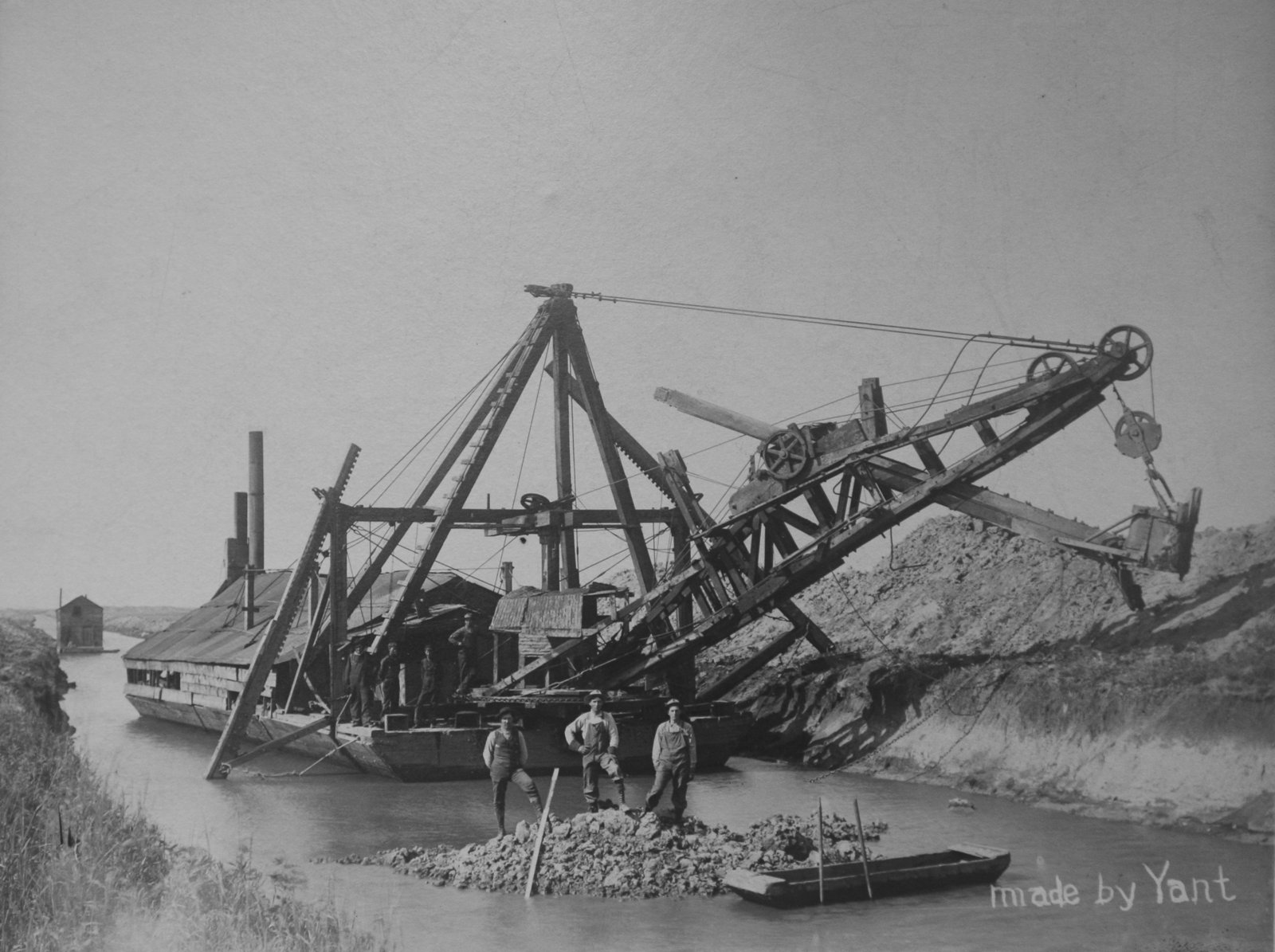
The Untold Story of Iowa’s Ag Drainage Systems
If there were a “Mysteries at the Museum” television series geared towards agriculture, this item would be ideal to lead in a segment. It’s hollow, it’s made of clay, it contains a message from the past, and it was buried in the ground for decades.
It’s a unique clay drainage tile dated 1885, and it’s on display in the Greene County Historical Society’s museum in Jefferson. The message carved around the exterior of the tile reads, “We the men who started the tile work did so with a motive to benefit the town and country. Signed T.P. LaRue of Scranton, Iowa.”
An interpretive sign by the tile shares a quote from S.J. Melson, a former Greene County engineer, to explain the curious item’s history. “This tile was placed into my hands by Carl Paup on February 1968. Mr. Paup stated the tile was unearthed and has lasted for many years on the property owned and operated by Harrison Paup of Kendrick Township, Greene County, Iowa.”
That tile reflects a major part of Iowa’s agricultural history that has been buried, literally, for generations, yet this history continues to influence farming methods, especially in the prairie pothole regions of north-central Iowa and northwest Iowa.
“In general, ag drainage in Iowa got its start around 1880, but this varied a lot, depending on the region,” said Joe Otto, a historian and Ph.D. candidate at the University of Oklahoma who works as a communications specialist with the Iowa Water Center at Iowa State University.
The first documented case of a drain tile being installed in Iowa occurred in 1868 on the grounds of Iowa State in Ames, Otto added. Before that, some of the first drainage ditches were dug in the 1850s along the Mississippi River in Des Moines County, just upstream from Burlington, so farmers could help protect themselves from flooding. One of these farmers, John Williams, was later elected to the state legislature and helped get the state’s first drainage laws passed in the 1870s, Otto said.
Drainage affected Iowa’s settlement patterns
Ag drainage was such a major issue in the 1800s that it impacted Iowa’s settlement. “Iowa wasn’t settled east to west, but from the bottoms up to the top of the state’s many river valleys,” Otto said. “Atop the river valleys were the flat, glaciated prairies of north-central and northwestern Iowa. These were settled and farmed starting in the 1870s and 1880s – several decades after farming started along the Mississippi.”
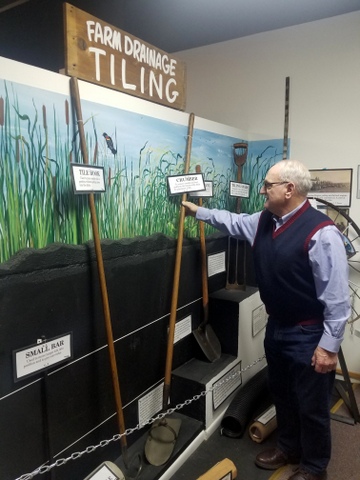
Jim Andrew revisits the exhibit designed by his father, James H. Andrew, a long-time Greene County farmer. This Farm Drainage Tiling exhibit is housed at the Greene County Historical Society’s museum in Jefferson, Iowa.
The region’s extensive swamps and sloughs were remnants of the last glacier, which loosened its icy grip on Iowa approximately 12,000 years ago. “There was a lot of water and nowhere for it to go,” Otto said. “Drainage ditches had to be dug and tile lines had to be laid before the sloughs and swamps of Iowa could be farmed. This started around 1880 and picked up speed in the early 1900s as drainage technology became more advanced.”
Ag leaders like Civil War veteran and pioneer farmer Jesse Allee, who settled in the Newell area in 1871, knew ag drainage would be essential to the development and prosperity of the region. “He was far-seeing with the unshakable belief in the future of the community’s farm land,” stated the 1969 Newell centennial history book on display at the Allee Mansion south of Newell. “Jesse worked hard educating the public to the necessity of proper drainage if this area was to be a leader in agriculture.”
Settlers in Greene County faced a similar situation. “By 1880, many landowners realized underground drainage tile was needed to remove the excess water,” wrote James H. Andrew, a long-time Greene County farmer who created the Farm Drainage Tiling exhibit at the Greene County Historical Society’s museum
in Jefferson before he passed away in 2014.
As more settlers moved into Iowa and demand for tile drainage grew, tile kilns and factories popped up across the state, Otto noted. Greene County, like many Iowa counties, had multiple firms manufacturing clay tile. These businesses used locally-sourced clay, including the Jefferson Cement Products Co., which was located just north of the Greene County Fairgrounds and operated until about 1930, and Lawton and Mass, which produced concrete tile at Cooper for a number of years, starting in 1895.
“There were also small machines made for farmers to mix concrete and scoop it into a manually-cranked device that used metal forms to make various sizes of tile,” wrote Andrew, who was known as “Mr. History.” “They advertised you could make your tile at home for half the cost of commercial tile. But it’s doubtful if this was very successful, since the proper steaming and curing of concrete tiles is important.”
Drainage districts take shape
Ag drainage in Iowa took a major leap forward in 1904, when state legislation provided for the formation of drainage districts. “Farmers could always drain their own lands if they wanted to, but to truly manage drained water meant cooperation with your neighbors,” Otto said.
A group of farmers could petition for a drainage district. An engineer would survey the land to establish the boundaries of the area, and a feasible drainage plan would be developed.
If approved, a contract would be drawn up, with the cost paid by assessing each landowner for his or her fair share, considering his needs and the acres involved. The county acted as the administrator of the drainage district and assessed taxes against the land, as needed, to pay for the initial cost and later for the maintenance of the drainage district. Many times, the money would be borrowed by issuing bonds, and the landowners would make payments on a 10-year plan, Andrew noted.
“The drainage district plan provided the larger tile needed for the main arteries of the system,” Andrew wrote. “Individual landowners were responsible for installing and paying for the lateral tile lines installed on their respective farms to complete the drainage plan.”
From 1904 to 1919, an average of 10 new drainage districts were created per year in Greene County. “That’s a new district about every five weeks,” Andrew wrote.
The 1910s became the golden age of ag drainage when most of Iowa’s public drainage systems were built, Otto added. “By 1912, Iowa’s farmers had spent more money on drainage then the U.S. government spent to build the Panama Canal.”
A Greene County drainage district created in 1916 to drain 998.7 acres using approximately 3.5 miles of tile ranging in size from 10 inches to 22 inches cost of $9,135, [more than $218,640 in today’s dollars], said Michelle Fields, drainage clerk for Greene County. “A drainage district created and installed in 2013 drained 865.5 acres using around 2.38 miles of tile ranging in size from 15 to 24 inches at a cost $532,500,” she added.
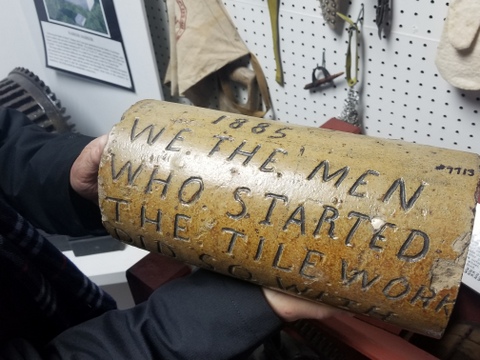
This unique clay ag drainage tile dated 1885 is on display in the Greene County Historical Society’s museum in Jefferson. The message carved around the exterior of the tile reads, “We the men who started the tile work did so with a motive to benefit the town and country. Signed T.P. LaRue of Scranton, Iowa.”
Recalling the life of a ditch digger
By 1920, the formation of ag drainage districts in Iowa slowed down as the post-World War 1 ag depression hit rural America. Still, the work continued.
“Steam power (and later gasoline) engines moved steel and iron machines that could move a lot more dirt around than could horse-drawn scrapers and plows,” Otto said.
Around 1923, after most Greene County drainage districts were in place, the first tiling machines started to be used, although hand digging continued for many years, Andrew noted. In the spring, summer and fall, men could find a job “in the ditch” if they wanted to work. “Many immigrants coming to the USA found their first jobs digging canals, and later drainage ditches. You didn’t have to know English to be a good man in the ditch,” added Andrew, who noted that many of these workers were from Sweden and Ireland.
The early tilers typically lived in tents or small, portable shacks next to the wet land they were draining. They often cooked their own meals and lived off the land by catching frogs for fried frogs’ legs and snapping turtles for turtle soup. They shot ducks, geese and rabbits for meat. Sometimes bullheads and other fish could be caught in the larger ponds, Andrew noted. For water, including drinking water, the men would take a post auger and dig a hole 3 to 4 feet deep and would set in an old farm pump.
“Ditch digging was well organized, and the men were paid by the rods of ditch dug by each man,” Andrew wrote. “No work—no pay. And of course, workmen’s compensation, health insurance and so on were unheard of.”
“Generous gifts”
By the 1970s, corrugated plastic pipe was introduced, which gradually phased out clay tile as the most efficient way to drain land. Today, Greene County has nearly 3,000 miles of drainage district tile and pipes, ranging from 4 inches to 48 inches in diameter. This distance would roughly equal a tile ditch spanning from New York to San Francisco.
“Note that the 3,000 miles is just a measure of the district tiles,” Fields said. “That number would be exponentially larger if you included private tile lines.”
As ag drainage issues have increasingly become intertwined with debates about conservation and water quality, it’s important to keep the line of communication open, Otto said.
“I think the harsh reaction against ag drainage that’s happened in the past few years is due in part to people suddenly wanting to engage in drainage matters, but unsure of what drainage is and does, who administers it and what powers they have. On the other side of the coin, the people trusted to manage the public’s interests in drainage have a responsibility to break down barriers, explain misconceptions and guide the conversation to a common ground.”
That’s a big reason why Andrew documented the history of ag tiling, counting it as one of the most important events in local history and the settlement of the region, noted his son, Jim Andrew of Jefferson.
“Think of the men and the effort it took to dig the clay, form and cure the tile, haul the tile to the jobsite, the survey crews working in ponds and swamps, the drainage plans made by the drainage engineer proving drainage was practical, the legal problems of objections and disputes, letting the bids, and, most important, the hundreds of men with strong backs who worked digging the ditches, laying the tile and filling the ditches,” wrote James H. Andrew.
“Yet, the tile is hidden underground, and the ‘Iron Men’ tilers are all deceased,” he concluded. “As time passes, there is little appreciation for the cooperative efforts that drained Greene County and made it so productive. Only when these old tile systems fail and have to be replaced at great expense will many people realize the generous gifts we’ve received from the drainage district system.”
Want more?
Thanks for stopping by. I invite you to read more of my blog posts if you value intriguing Iowa stories and history, along with Iowa food, agriculture updates, recipes and tips to make you a better communicator.
If you like what you see and want to be notified when I post new stories, be sure to click on the “subscribe to blog updates/newsletter” button at the top of this page, or click here. Feel free to share this with friends and colleagues who might be interested, too.
Also, if you or someone you know could use my writing services (I’m not only Iowa’s storyteller, but a professionally-trained journalist with 20 years of experience), let’s talk. I work with businesses and organizations within Iowa and across the country to unleash the power of great storytelling to define their brand and connect with their audience through clear, compelling blog posts, articles, news releases, feature stories, newsletter articles, social media, video scripts, and photography. Learn more at www.darcymaulsby.com, or e-mail me at yettergirl@yahoo.com.
If you’re hungry for more stories of Iowa history, check out my top-selling “Culinary History of Iowa: Sweet Corn, Pork Tenderloins, Maid-Rites and More” book from The History Press. Also take a look at my latest book, “Dallas County,” and my Calhoun County” book from Arcadia Publishing. Both are filled with vintage photos and compelling stories that showcase he history of small-town and rural Iowa. Order your signed copies today! Iowa postcards are available in my online store, too.
Let’s stay in touch. I’m at darcy@darcymaulsby.com, and yettergirl@yahoo.com.
Talk to you soon!
Darcy
@Copyright 2019 Darcy Maulsby & Co. Blog posts may only be reprinted with permission from Darcy Maulsby.
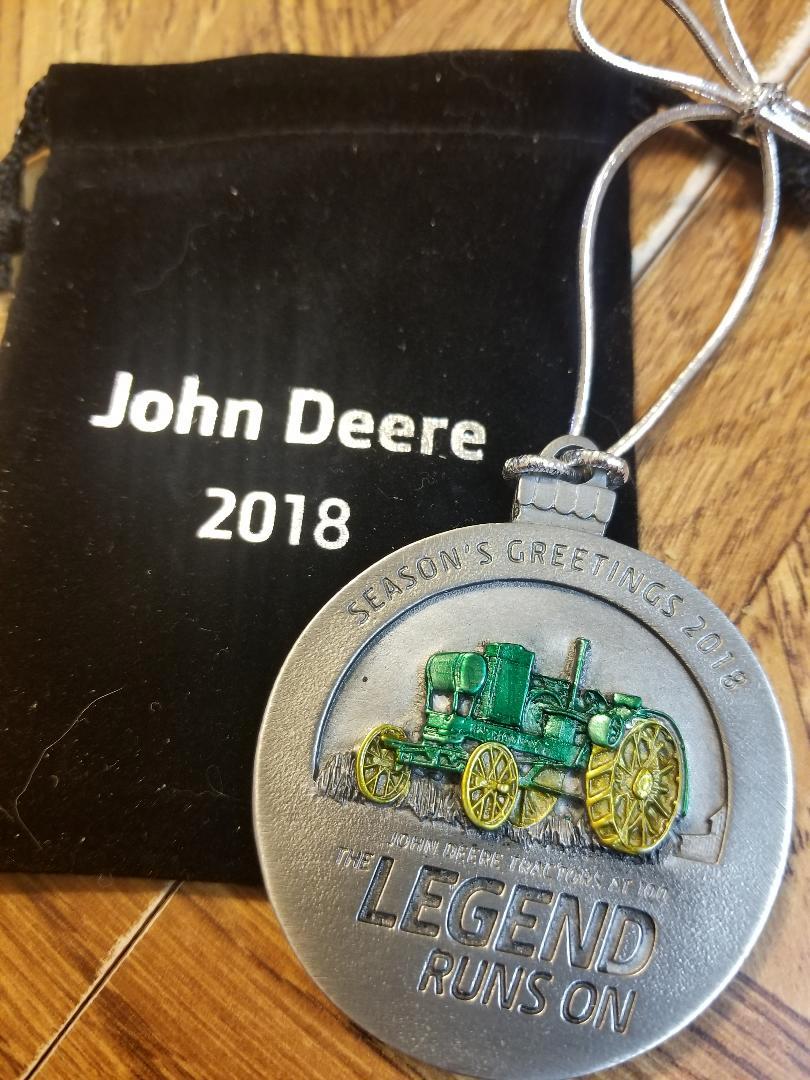
Butter Sculptures to Christmas Ornaments: Waterloo Boy Tractor Celebrates 100 Years
It’s hard to imagine a time when John Deere wasn’t a powerhouse in the tractor business. Yet, John Deere wouldn’t enter the farm tractor business until March 1918 through the acquisition of the Waterloo Gasoline Engine Company, and it’s a milestone that has been commemorated in everything from butter to Christmas ornaments.
Deere has featured a picture and story depicting the 100th anniversary of the iconic Waterloo Boy on its 2018 Christmas ornament. The 2018 Iowa State Fair also honored the tractor by featuring the world-famous Butter Cow beside a butter sculpture of the Waterloo Boy. Both butter masterpieces were displayed in the 114-year old John Deere Agriculture Building’s 40-degree cooler throughout the fair, which ran from August 9-19.
The Iowa State Fair has long been a prime venue to display Deere equipment in its various forms. A quote from the John Deere Sales Department in 1940 read, “I feel that the machinery and industrial exhibits for 1940 excelled any previous year’s display,” according to history shared by the Iowa State Fair. “We consider our Iowa State Fair exhibit to be a very beneficial part of our advertising program, and we will be with you again in 1941.’”
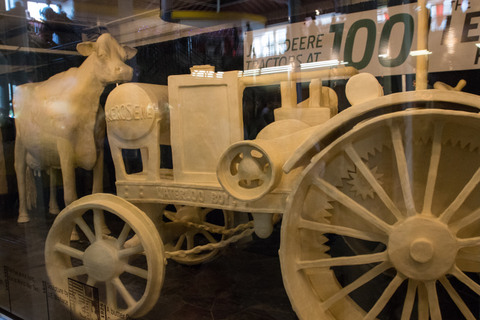
Waterloo Boy butter sculpture 2018 Iowa State Fair
Meeting the challenge of a reliable, durable tractor
Frequently ranked as one of the top events in the country, the Iowa State Fair is the single largest event in the state of Iowa and one of the oldest and largest agricultural expositions in the country and annually attracts more than a million people from all over the world.
In 2018, the Iowa State Fair used more than 50 John Deere tractors and utility vehicles provided by Van Wall Equipment. In addition, a 1919 Waterloo Boy model N tractor was on display in the Machinery Grounds at the Iowa State Fair.
To understand the significance of the Waterloo Boy, take a trip back in time, said Neil Dahlstrom, manager of the John Deere Archives and History. In the critical five-year stretch (1912-1917) prior to John Deere entering the tractor business, there were two key issues the company needed answered.
“First, what did farmers really want from a machine that would soon make the horse obsolete?” said Dahlstrom, who noted that salesmen, territory and branch managers, and Deere’s top leadership scoured the country to understand what customers desired.
Also, how could the equipment to be manufactured to be durable enough to stand up to daily farm use?
Deere had considered every imaginable idea. The company had developed one-, two- and four-cylinder concept tractors. Some ran on gasoline. Others ran on kerosene. Some had all-wheel drive. Others had front-wheel drive. The company even explored concepts like line steering, which was meant to replicate horse reins as the steering mechanism to ease farmers into power farming, Dahlstrom said.
A motorized cultivator, what Deere called a “Tractivator,” was brought to market by several competitors, but Deere determined it did not provide any cost savings compared to horses.
The challenge of producing a durable tractor loomed large. In a letter to company president William Butterworth in 1915, Deere’s superintendent of factories George Mixter noted that tractors offered by competitors up to that point “have not been built with the proper spirit behind the design and manufacture to insure their durability in the hands of the farmers.” But if Deere could “build a small tractor that will really stand up for five or more years’ work on the farm, I believe they will be a permanent requirement of the American farmer,” Mixter wrote.
Deere ultimately found the solution with the Waterloo Boy tractor and acquired the Waterloo Gasoline Engine Company in Waterloo, Iowa, on March 14, 1918. Although anxious to start selling the Waterloo Boy, Deere dealers had to wait while Deere honored existing contracts, which did not expire until Dec. 31, 1918, Dahlstrom said.
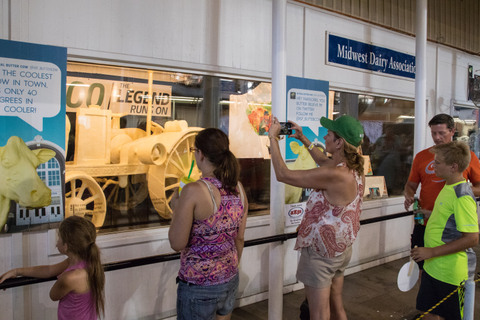
Visitors snapped photos of the iconic Waterloo Boy butter sculpture 2018 Iowa State Fair.
Waterloo Boy makes its debut
Deere put its money where its instincts were. Over the next year, the company spent more than one-third of its advertising budget touting the Waterloo Boy tractor, Dahlstrom said.
Specifically, Deere invested $50,000 on tractor advertising in the year following its debut of the Waterloo Boy—approximately $747,000 in today’s money. Another way to get the company’s new product out in front of customers was to take it on the road – literally.
The National Tractor Demonstrations started to become more mainstream after being introduced in the United States in 1913. An eight-city, eight-week tour schedule was the perfect opportunity to unveil Deere’s Waterloo Boy, Dahlstrom said. Salina, Kansas, served as the ideal backdrop in August 1918, since this was the nation’s largest demonstration.
Deere had participated in tractor demonstrations since the original Winnipeg Agricultural Motor Competitions in Manitoba, Canada, in 1908 – but not with a tractor. Instead, Deere had paired its plows with leading tractor manufacturers. That changed now that the Waterloo Boy was part of the Deere family.
At Salina, Deere spared no expense, showcasing 12 Waterloo Boy tractors as the centerpiece of a display that included John Deere signs, Waterloo Boy signs and a copper leaping deer statue, Dahlstrom said. “There were two stars during this week of 100-degree days – ‘ice water on tap’ and the Waterloo Boy Model ‘N’ tractor,” he added.
The Model “N” demonstrated its merits by pulling tractor plows, disc harrows and grain drills. Visitors were shuttled in three John Deere farm wagons pulled by Waterloo Boy tractors. By all accounts, the debut was a success.
“The award for the most elaborate, largest and most artistic exhibit tent at the Salina tractor show will undoubtedly go to the John Deere Plow company of Kansas City,” wrote the editors of a Kansas City newspaper.
As Deere’s advertising campaign swung into full gear, the Waterloo Boy tractor was promoted as the “best and most efficient tractor” on the market for farmers inclined to buy a tractor. By October 1918, readers of Deere’s magazine, The Furrow, saw an advertisement for the line of Waterloo Boy tractors and stationary engines. The ad guaranteed the Waterloo Boy’s “ample power for field and belt work.”
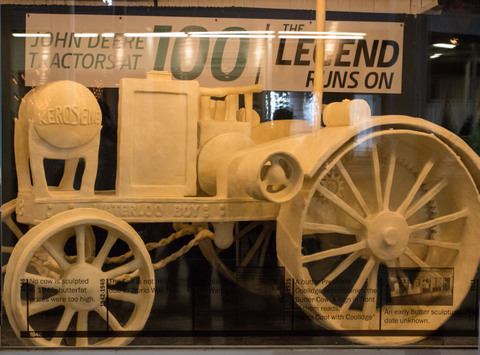
Waterloo Boy butter sculpture 2018 Iowa State Fair
In January 1919, with tractors now available through John Deere dealers, Deere’s first print ad for the trade press appeared in The Farm Implement News. It featured two areas of emphasis: “A Good Tractor Backed by a Permanent Organization.”
After years of development, John Deere customers and John Deere dealers finally had their John Deere tractor.
“It took longer than the company expected, but a determination to do it right instead of doing it fast now brought the John Deere tractor to market,” Dahlstrom said.
As a result, customers got “the assurance of more tractor work per dollar of fuel cost; longer tractor life with less repair cost; accessibility of parts that makes caring for the tractor simple and easy; and dependable power for all farm work.”
The tractor era had officially arrived.
Want more?
Thanks for stopping by. I invite you to read more of my blog posts if you value intriguing Iowa stories and history, along with Iowa food, agriculture updates, recipes and tips to make you a better communicator.
If you like what you see and want to be notified when I post new stories, be sure to click on the “subscribe to blog updates/newsletter” button at the top of this page, or click here. Feel free to share this with friends and colleagues who might be interested, too.
Also, if you or someone you know could use my writing services (I’m not only Iowa’s storyteller, but a professionally-trained journalist with 20 years of experience), let’s talk. I work with businesses and organizations within Iowa and across the country to unleash the power of great storytelling to define their brand and connect with their audience through clear, compelling blog posts, articles, news releases, feature stories, newsletter articles, social media, video scripts, and photography. Learn more at www.darcymaulsby.com, or e-mail me at yettergirl@yahoo.com.
If you’re hungry for more stories of Iowa history, check out my top-selling “Culinary History of Iowa: Sweet Corn, Pork Tenderloins, Maid-Rites and More” book from The History Press. Also take a look at my latest book, “Dallas County,” and my Calhoun County” book from Arcadia Publishing. Both are filled with vintage photos and compelling stories that showcase he history of small-town and rural Iowa. Order your signed copies today! Iowa postcards are available in my online store, too.
Let’s stay in touch. I’m at darcy@darcymaulsby.com, and yettergirl@yahoo.com.
Talk to you soon!
Darcy
@Copyright 2018 Darcy Maulsby & Co. Blog posts may only be reprinted with permission from Darcy Maulsby.
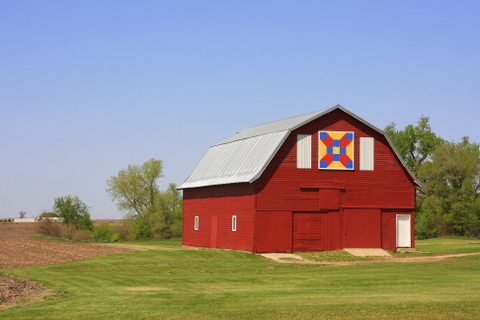
Pieced Together: Barn Quilt Documentary Features Iowa Stories
Barn quilts have become a folk-art phenomenon in Iowa in the past 15 years, turning up not only on barns, but mailboxes, gardens, buildings in town and more. But there was a time not that long ago when no one had ever heard of a barn quilt—not until Donna Sue Groves wanted to add a little color to her corner of the world.
Her story—and those of barn quilt enthusiasts in places like Sac County—inspired the 53-minute documentary “Pieced Together,” which filmmaker Julianne Donofrio showed in Sac City to a full house at the First Christian Church on the evening of Sept. 24, 2018.
“A lot of people don’t know where barn quilts came from,” said Donofrio, who is from the New York City/Washington, D.C. area. “I want people to know Donna Sue’s story.”
The story, which includes many barn quilts across Iowa, began in 1989 when Groves’ family bought a farm in Adams County, Ohio, near the Ohio River Valley at the foothills of the Appalachian Mountains. Groves made a casual remark to her mother, Nina Maxine Groves, about an uninspiring, time-worn tobacco barn on the farm.
“It was the ugliest barn I’d ever seen,” Groves said in “Pieced Together.” “I joked to my mother, ‘I’ll paint you a quilt square on it someday.’”
Game inspires a lifelong love of barns
Groves’ interest in barns dates back to her childhood. When her family would visit Groves’ grandmother in Roane County, West Virginia, Groves’ mother invented a car game to keep Groves and her brother quiet.
“You couldn’t play the typical license plate game when you’re traveling the back roads of West Virginia, because all you saw were West Virginia license plates,” Groves said. “Mother created a car game where we counted barns.”
Some barns were worth two points, while others were worth three points. If a barn had outdoor advertising, like “Chew Mail Pouch” or “RC Cola,” players got a 10-point bonus if they could read the lettering. Red barns also earned higher points. The chance to earn even more points awaited when the family’s wider travels took them past Pennsylvania Dutch barns with colorful, geometric hex signs.
The game led to discussions and questions about the barns, such as who built the barns, and for what purpose. Groves enjoyed these conversational teaching moments. “I looked forward to seeing barns,” she said.
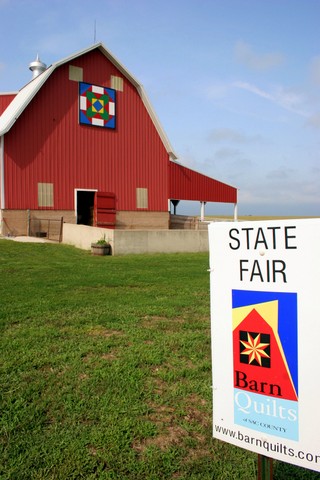
Sac County Iowa barn quilt
Creating a clothesline of quilts across America
This history eventually inspired Groves’ involvement with the first barn quilt square, an Ohio Star pattern, which was created in October 2001 and displayed in Adams County, Ohio. This small gesture triggered a ripple effect across North America.
“If we didn’t pick up on this idea, someone else would,” said Groves’ mother, Maxine, who was featured in “Pieced Together.”
As more people wanted to create barn quilts, Groves and her fellow volunteers quickly learned that painting barn quilts directly onto barns didn’t work too well, but painted plywood squares offered a much better option.
Why stop with just a few barn quilts, though? “A trail of barn quilts could bring tourists here to see all the wonderful things Adams County offers,” noted Groves, who has served as a field representative for the Ohio Arts Council. “Then they’d stay in our bed-and-breakfasts and motels and eat at our restaurants.”
These opportunities for economic development, combined with the visual appeal of barn quilts, soon inspired a “clothesline of quilts” across America. Residents of an adjoining county, Brown County, Ohio, loved Groves’ idea and asked how to get involved. Folks in Tennessee read an article about the Ohio barn quilt project, called Groves and wanted to know how to do a similar project in their area. Grundy County, Iowa, also got involved in 2003, followed by Sac County.
When Sue Peyton and her family from rural Sac City heard about barn quilts, it seemed like a good fit for her son, Kevin, who was in high school and looking for a project he could use as a 4-H leadership project and a Herbert Hoover Uncommon Student Award project.
“I immediately fell in love with the project when I heard about it,” Sue Peyton said. “Barns and barn quilts are such a natural fit.”
The Peytons coordinated the construction and painting of Sac County’s first barn quilts in the summer of 2005. While some people weren’t quite sure what to make of the new barn quilts that started appearing on barns and corncribs around the county, the concept caught on quickly. “We hoped to get 20 barn quilts,” said Sue Peyton, who added that Sac County boasted 55 barn quilts within two years of the start of the project.
“I’ve seen a lot of quilt trails, and you embraced this early on and have done a tremendous job,” said Donofrio as she chatted with audience members in Sac City following her documentary.

Sac County barn quilt proponents Kevin Peyton and his mother, Sue, (center) welcomed filmmaker Julianne Donofrio, who showed her 53-minute documentary “Pieced Together” in Sac City to a full house at the First Christian Church in September 2018.
“We’re here to stay”
Anywhere there’s a barn quilt trail, every square tells a story. Also, there’s no right or wrong way to create a barn quilt. “Barn quilts have a storied history as complex and diverse as the quilt patterns themselves,” Kevin Peyton said.
Consider the Double Aster barn quilt pattern on the Hogue family’s 1943 barn north of Odebolt. The pastel-colored design complements the family’s Prairie Pedlar Gardens business. Owner Jane Hogue, who served on the original Sac County Barn Quilt Committee, enjoyed watching the “Pieced Together” documentary.
“It was fun to see the snippets of Sac County’s barn quilts in the film,” she said. “We’re proud to be part of Sac County’s barn quilt project. With our gardens and tourism, it’s a win-win.”
Sac County proves that barn quilts offer an effective way to help save barns, promote rural tourism and boost economic development, Sue Peyton added. She cited the vintage barn at the Rustic River Winery and Vineyard north of Lake View, for example. It has been remodeled not only into a winery, but a venue where people can host parties and other gatherings.
As the history of the barn quilt phenomenon is preserved through projects like “Pieced Together,” barn quilts are being praised as one of the greatest community art projects ever created. While there are barn quilt trails in 42 states, there is no national barn quilt organization, by design. Creating barn quilts at the local allows local people to make their mark, share their history and establish a legacy. “It’s so adaptable—that’s the beauty of it,” Groves said.
Above all, barn quilts inspire people to view rural communities in a new way. “Barn quilts prompt a question that starts a discussion,” noted a speaker in the “Pieced Together” documentary. “It’s a statement that, ‘We’re here, and we’re here to stay.’”
Barn quilts also prove the power of one person from an isolated rural county to inspire a vision that has touched an entire nation. “As times get harder, we forget how to dream,” said Groves, a cancer survivor. “I like to think the barn quilt trails allow people to dream.”
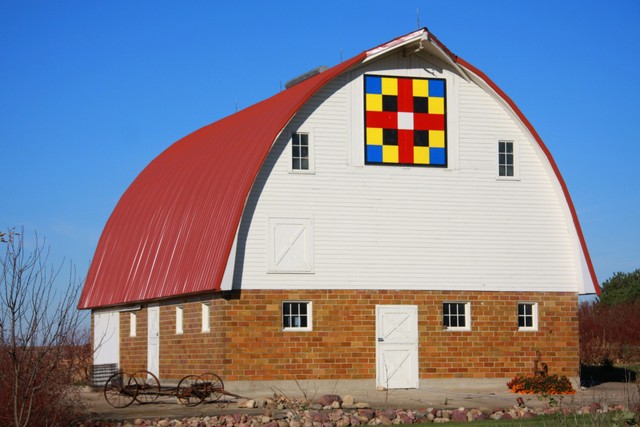
Sac County barn quilt near Early, Iowa
Want more?
Thanks for stopping by. I invite you to read more of my blog posts if you value intriguing Iowa stories and history, along with Iowa food, agriculture updates, recipes and tips to make you a better communicator.
If you like what you see and want to be notified when I post new stories, be sure to click on the “subscribe to blog updates/newsletter” button at the top of this page, or click here. Feel free to share this with friends and colleagues who might be interested, too.
Also, if you or someone you know could use my writing services (I’m not only Iowa’s storyteller, but a professionally-trained journalist with 20 years of experience), let’s talk. I work with businesses and organizations within Iowa and across the country to unleash the power of great storytelling to define their brand and connect with their audience through clear, compelling blog posts, articles, news releases, feature stories, newsletter articles, social media, video scripts, and photography. Learn more at www.darcymaulsby.com, or e-mail me at yettergirl@yahoo.com.
If you’re hungry for more stories of Iowa history, check out my top-selling “Culinary History of Iowa: Sweet Corn, Pork Tenderloins, Maid-Rites and More” book from The History Press. Also take a look at my latest book, “Dallas County,” and my Calhoun County” book from Arcadia Publishing. Both are filled with vintage photos and compelling stories that showcase he history of small-town and rural Iowa. Order your signed copies today! Iowa postcards are available in my online store, too.
Let’s stay in touch. I’m at darcy@darcymaulsby.com, and yettergirl@yahoo.com.
Talk to you soon!
Darcy
@Copyright 2018 Darcy Maulsby & Co. Blog posts may only be reprinted with permission from Darcy Maulsby.
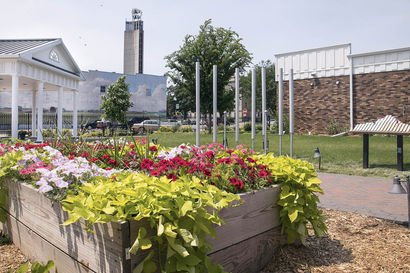
Digging Deeper: Volunteers Showcase Thomas Jefferson Gardens in Iowa
What comes to mind with the name Thomas Jefferson? President, perhaps? Avid agriculturist and gardener also fit, especially in Jefferson, where locals are quick to share this rich history.
“Cultivators of the earth are the most valuable citizens,” Jefferson wrote in 1785 to John Jay, a fellow founder of the United States and first chief justice of the United States. “They are the most vigorous, the most independent, the most virtuous, and they are tied to their country and wedded to its liberty and interests by the most lasting bonds.”
Jefferson frequently extolled the virtues of the agrarian life and championed self-government. His legacy and ideals are honored on in the Thomas Jefferson Gardens of Greene County, Iowa (TJGGCI), in downtown Jefferson, thanks to dedicated volunteers, local civic groups and other community-minded supporters.
A life-sized statue of Jefferson himself greets visitors to the gardens, which surround the local Welcome Center/chamber of commerce office southeast of the Greene County courthouse. “The statue is so lifelike that I think a person is sitting there when I catch a glimpse of it while I’m working,” said Jean Walker, head gardener and secretary of the TJGGCI.
Jefferson’s interest in agriculture blends seamlessly with a rural community like Jefferson that honors its ag heritage and looks for new ways to promote the area, said John Turpin, a retired social studies teacher and coach from Jefferson who serves as treasurer and historian for the TJGGCI. “Jefferson was a student of the flora and fauna in his home state of Virginia. He also thought agriculture was the most important career a person could have.”
Making something out of nothing
So what came first in Jefferson—the statue or the garden? It all started in 2010 when Wallace Teagarden, a Greene County native, lawyer and long-time admirer of Jefferson’s philosophies, wanted to combine his love of agriculture and Greene County in a lasting legacy to the author of the Declaration of Independence.
Teagarden commissioned Jon Hair, an Iowa native and world-renowned sculptor, to create a statue of Jefferson. While displaying the statue on the courthouse lawn was the original idea, it was decided that the statute should become focal point of the new TJGGCI, located just down the street to the east of the iconic Mahanay Bell Tower.
A great deal of work went into creating the nearly $1 million gardens that visitors enjoy today. “This lot where the gardens are had three dilapidated old buildings on it that had to be removed,” said Mary Weaver, who leads 12-member volunteer board of the TJGGCI.
The ground itself wasn’t ideal, either. Old cans and other debris were buried in the corner behind the area where a filling station once stood on the property. “Multiple truckloads of soil were hauled in here,” Walker said.
Before some of the first plants could even be planted, grant writing and fundraising were essential. Project leaders received grants from Vision Iowa and Grow Greene County, along with support from Alliant Energy, West Central Cooperative (which is now Landus Cooperative, the Greene County Board of Supervisors, and countless other groups and individuals.
By 2014, the first plants were added to the new garden. Today, brick paving connects the five distinct gardens in the TJGGCI, including:
• The farmer’s garden on the east. Volunteers have grown broom corn, white corn, pumpkins, squash, Yukon Gold potatoes, flax and more in this garden, which is near a replica of Jefferson’s “mouldboard of least resistance” for a plow. While serving as minister to France, Jefferson had the opportunity to observe European plow designs. Their deficiencies inspired him to design an improved moldboard (the part of the plow that lifts up and turns over the sod cut by the plow share). He wished to make that lifting and turning action as efficient as possible so the plow could be pulled through the soil with the least expenditure of force. He never sought to patent his design and sent numerous models to friends at home and abroad, where his design met with general approval.
• A prairie garden on the north, filled with native plants. “This is what Lewis and Clark would have seen when they explored Iowa following the Louisiana Purchase,” Turpin said.
• A children’s garden, with beds made from old wagon wheels. This fun garden showcases unique plants like the sensitive plant, whose leaves and stems curl up when touched.
• A flower and rose garden on the west. This garden is filled with 1,000 plants, including many perennials ranging from irises to daylilies. This garden also includes Buck roses, which are hardy varieties developed by Dr. Griffith Buck from Iowa State University. In addition, some of the plants in the garden have been donated from local gardens, including two peony plants that are more than 100 years old, Walker said. Those are located near the garden’s striking pavilion, a Federal design reminiscent of architectural styles associated with Jefferson. Even the little free library in the garden near the pavilion reflects Jefferson’s legacy, since it’s designed to look like Monticello, Jefferson’s estate in Virginia.
• Five raised garden beds on the south. Grapevines grow on a cedar trellis just to the south of the raised beds. The raised beds are used to grow various vegetables that are donated to the local food pantry and congregate meal program. “The first year we planted crops like parsnips, turnips and kohlrabi that Jefferson planted in his own gardens,” Walker said. “Those didn’t prove very popular here, though, so we grow peppers, heirloom tomatoes, peas, green beans and more.”
Learning and growing
Since Thomas Jefferson was interested in music as well as agriculture, the TJGGCI project leaders added whimsical, larger-than-life musical instruments, including a contra base chime and xylophone, to bring sound to the garden.
“We were inspired by the outdoor instruments at Okoboji in the Arnolds Park area,” said Jacque Andrew of Jefferson, who handles marketing for the TJGGCI. “Anyone can play these instruments, and they make the garden more interactive.”
So far, there has been one wedding in the garden in 2016. Tour groups from Des Moines to South Dakota have also visited the gardens.
Volunteers continue to work to make the garden even more inviting. They hope to add a third musical instrument and are hosting another year of Tuesday Talks. These free, educational lectures are held in the garden each Tuesday from noon until 1 p.m. through mid[August. Topics range from perennial gardening to birds in the garden. “A garden is always a work in progress,” Walker said.
That’s part of what brings people together and makes this project inspiring, Weaver added. “These gardens make me so proud of the community. We want to help Jefferson and Greene County become a destination, and the gardens are an important part of this.”
People are listening
P.S. I received this wonderful note from Mary Weaver after this article I wrote ran in Farm News in July 2018:
“On a very pleasant note, we are getting visitors because of the articles. We have, that we are aware of, three different sets of visitors from Humboldt. It is the type of visitor story we will tell the City Council when we report to them in September.
The best anecdote was a woman who was part of an assisted living bus tour that was coming to Jefferson from Humboldt, but the destination was the casino. She persuaded the driver her to bring her to TJG rather than the casino and she stayed the entire length of time the others were gambling.
The second was a couple I met yesterday during Tuesday Talks. It was their second visit for a “Tuesday Talk,” they ate at a local restaurant, went shopping at the quilt and antique store.
Certainly is the type of economic/tourism development we have been hoping to create. Thank you Darcy for your splendid articles about the Thomas Jefferson Gardens.”
Want more?
Thanks for stopping by. I invite you to read more of my blog posts if you value intriguing Iowa stories and history, along with Iowa food, agriculture updates, recipes and tips to make you a better communicator.
If you like what you see and want to be notified when I post new stories, be sure to click on the “subscribe to blog updates/newsletter” button at the top of this page, or click here. Feel free to share this with friends and colleagues who might be interested, too.
Also, if you or someone you know could use my writing services (I’m not only Iowa’s storyteller, but a professionally-trained journalist with 20 years of experience), let’s talk. I work with businesses and organizations within Iowa and across the country to unleash the power of great storytelling to define their brand and connect with their audience through clear, compelling blog posts, articles, news releases, feature stories, newsletter articles, social media, video scripts, and photography. Learn more at www.darcymaulsby.com, or e-mail me at yettergirl@yahoo.com.
If you’re hungry for more stories of Iowa history, check out my top-selling “Culinary History of Iowa: Sweet Corn, Pork Tenderloins, Maid-Rites and More” book from The History Press. Also take a look at my latest book, “Dallas County,” and my Calhoun County” book from Arcadia Publishing. Both are filled with vintage photos and compelling stories that showcase he history of small-town and rural Iowa. Order your signed copies today! Iowa postcards are available in my online store, too.
Let’s stay in touch. I’m at darcy@darcymaulsby.com, and yettergirl@yahoo.com.
Talk to you soon!
Darcy
@Copyright 2018 Darcy Maulsby & Co. Blog posts may only be reprinted with permission from Darcy Maulsby.

Sac County Barn Quilt Attracts National Attention
When Alvin (Al) Liske and his wife, Jean, signed up for the Barn Quilts of Sac County project, they had no idea how much attention this would attract to their stately World War II-era barn west of Early, Iowa.
“Our barn has been featured in Eleanor Burns’ book, ‘Quilt Blocks on American Barns,’ and it was also included on the cover of the Department of Transportation’s 2009 map of Iowa,” said Jean.
Burns, a popular television personality who gained famed for her “Quilt in a Day” system, visited the Liske barn last year when she traveled to Iowa to participate in the Sac County Quilt-a-Fair. She was especially intrigued by the Country Lanes barn quilt pattern that graces the barn’s haymow door. She noted that Country Lanes is a very old pattern that was originally published by Mountain Mist, a company that began selling quilt batting in Cincinnati in 1846.
“We chose the Country Lanes block, because we live on a gravel road,” said Jean, who works in the registrar’s office at Buena Vista University in Storm Lake. “Even though we’re off the beaten path, it’s not uncommon to see people drive out here and take photos of the barn.”
Jean’s father, Herman Puetz, built the barn for approximately $4,000 around 1943 or 1944 on the Boyer Valley Township farm that his family had purchased in 1930. The new barn replaced an existing barn that was made from cottonwood lumber. After the concrete foundation for the new barn was poured, lumber was not readily available for the building, due to the war. In the meantime, the family roller skated on the concrete slab. “When construction started again, I can also remember going with my parents to Albert Lea, Minn., to get the rafters for the barn, and I thought that was a really long trip,” said Jean, who noted that the barn includes glazed tile on the bottom and originally had wood shingles on the rounded, gothic roof.
Herman kept horses in the barn, said Jean, who added that farming with horses could be dangerous. “One time when my Uncle George was hauling manure on our farm, something spooked the horses, and they ran toward a barbed wire fence. My uncle jumped off, and he broke his ankle, which got infected.”
Jean’s father, who was one of 12 children, also milked cows on the east side of the barn and kept plenty of hay in the haymow. “I’d play in the barn with my brothers and sister, and we’d make tunnels and caves and houses with the bales. When enough hay had been fed, there would be bare spots in the haymow, and we’d play basketball up there,” said Jean, who noted that the haymow still includes basketball hoops.
After Jean married Al and the couple moved to the farm where Jean grew up, the Liskes raised cattle and hogs in the barn and farmed from the early 1960s until the 1980s. In 2005, the couple decided to remodel the barn, which still had a good foundation. “It was getting to the point where we needed to fix up the barn or think about tearing it down, and we didn’t want to watch the barn fall down,” said Jean, who noted that the family power washed the interior, rebuilt windows and doors, had the barn rewired, covered the roof with red steel and added a staircase to the haymow.
The barn, which is now used for storage, became
a favorite play area for the Liske’s grandchildren. “The barn is an important part of our family’s heritage, and it’s one of the few old buildings left on this farm,” Jean said. “My dad was always proud of the barn, and we’re glad we’ve maintained it.”
Note from Darcy: I first wrote this piece in 2010 for Farm News.
Want more?
Thanks for stopping by. I invite you to read more of my blog posts if you value intriguing Iowa stories and history, along with Iowa food, agriculture updates, recipes and tips to make you a better communicator.
If you like what you see and want to be notified when I post new stories, be sure to click on the “subscribe to blog updates/newsletter” button at the top of this page, or click here. Feel free to share this with friends and colleagues who might be interested, too.
Also, if you or someone you know could use my writing services (I’m not only Iowa’s storyteller, but a professionally-trained journalist with 20 years of experience), let’s talk. I work with businesses and organizations within Iowa and across the country to unleash the power of great storytelling to define their brand and connect with their audience through clear, compelling blog posts, articles, news releases, feature stories, newsletter articles, social media, video scripts, and photography. Learn more at www.darcymaulsby.com, or e-mail me at yettergirl@yahoo.com.
If you’re hungry for more stories of Iowa history, check out my top-selling “Culinary History of Iowa: Sweet Corn, Pork Tenderloins, Maid-Rites and More” book from The History Press. Also take a look at my latest book, “Dallas County,” and my Calhoun County” book from Arcadia Publishing. Both are filled with vintage photos and compelling stories that showcase he history of small-town and rural Iowa. Order your signed copies today! Iowa postcards are available in my online store, too.
Let’s stay in touch. I’m at darcy@darcymaulsby.com, and yettergirl@yahoo.com.
Talk to you soon!
Darcy
@Copyright 2018 Darcy Maulsby & Co. Blog posts may only be reprinted with permission from Darcy Maulsby.
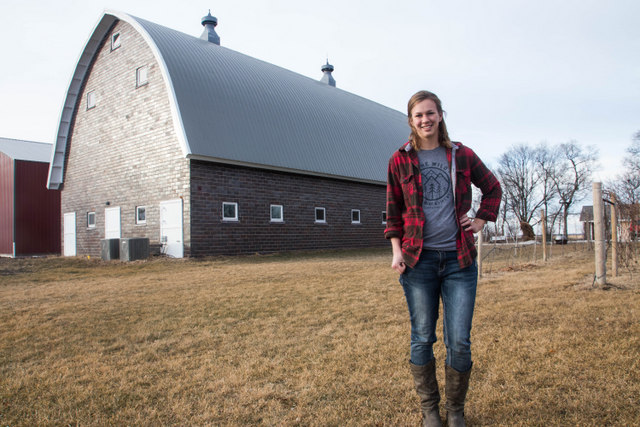
Events Spark Stories That Help Backcountry Winery Grow in Iowa
Ask Amber Gable about the back story behind Backcountry Winery at her family’s home east of Stratford, and her answer is straightforward. “It’s a hobby out of control.”
That hobby has taken Gable and her husband, Preston, on dynamic journey that has led to the creation of a small business that’s helping spur economic development in rural Iowa. At the heart of it all is a century-old barn that’s central to the story, offering an attractive venue for gatherings, celebrations, music concerts and more.
“This barn is such a unique building,” said Amber Gable, 27, who grew up on a farm near Sibley. “There’s so much history here, including original interior boards that have Stratford Grain and Supply stamped on them.”

Beyond the tasting room on the main floor, the barn loft holds 150 people.
Guests who come to Backcountry Winery for bridal showers, wedding receptions, class reunions and other celebrations enjoy exploring this rural heritage. So do the visitors who stop by for Backcountry Winery’s live music events.
“When we’re open on Saturday afternoons without a special event like live music, we tend to have smaller crowds,” Gable said. “Events help create experiences that people seek out.”
Events of all types have become an increasingly important part of running a successful winery, noted Mike White, a viticulture specialist for Iowa State University Extension. “More wineries are realizing that there’s big potential in event centers, and many are going this way.”
Putting down roots in Hamilton County
For many guests, part of the experience involves learning the story of the winery. In the case of Backcountry Winery, that story began with Preston Gable’s long-time interest in home winemaking.
“We’d talk about how we might open a winery someday,” said Amber Gable, whose husband is a fellow northwest Iowa native from Hartley.
“Someday” seemed far off, however, when the high school sweethearts started their careers in Ames following their graduation from Iowa State University (ISU). Amber Gable became a landscape designer for an engineering firm, while her husband worked in biofuels research at ISU.
When the couple began looking for an affordable acreage in central Iowa where they could establish a home, start a family and maybe operate a winery eventually, the process became frustrating at times. “We actively looked for about a year and often came up with nothing,” Amber Gable said. “There were some tears along the way.”
Things turned around in 2014, though, when the young couple found an acreage with a house and barn northeast of Stratford. “We really needed a fixer-upper, and this place needed a family to put down roots,” Amber Gable said.
After the couple purchased the property in August 2014, they began remodeling the barn within a few months and exploring its history. The abstract for the property goes back to 1920, when the current home on the acreage was built by Alfred Erickson. “We know the barn pre-dates 1920, although we don’t know exactly when it was built,” Amber Gable said.
While the barn is structurally sound, time had taken a toll on some parts of the building. “We poured a new concrete floor and replaced the entire hayloft floor,” said Amber Gable, who noted that the barn once housed cattle.
After months of work, the Gables opened Backcountry Winery in May 2016. “The barn is still a work in progress, but it has allowed us to open our winery sooner than we anticipated,” said Amber Gable, who appreciates the opportunity to run a home-based business, especially now that she and her husband are raising their 1-year-old son, Ivan.
Word-of-mouth marketing, Backcountry Winery’s website and a Facebook page have helped the couple’s business grow. While Backcountry Winery hosted one wedding in 2016, this grew to five weddings in 2017 and has increased to seven weddings slated for 2018.
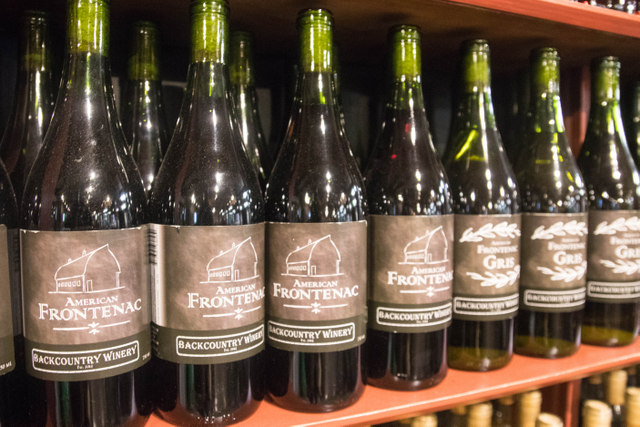
At Backcountry Winery, the Gables grow six varieties of wine grapes. They make 12 different wines, including strawberry, raspberry, cherry and apple wines, and plan to expand to 14 wines soon.
The Gables have invested in an expansion near the barn to accommodate these events. A connecting space on the west side of the barn will include a room when brides can get ready for their wedding. This connecting space is attached to a 60-foot by 90-foot addition that will provide additional production space, storage space and office space for the winery.
This infrastructure is just one part of Backcountry Winery’s recent expansions. While the Gables maintain a vineyard on the east side of the barn, the couple also began leasing an established, 4-acre vineyard near Webster City in the spring of 2017.
“It’s exciting to raise more of our own grapes so we can produce estate wines, which are made from our own crop,” said Amber Gable, who is a member of the Iowa Wine Growers Association. “There’s a great deal of pride in that.”
Wine wins big at Iowa State Fair
This pride is reflected in the large, silver trophy that graces the barn at Backcountry Winery. When the Gables competed in the commercial wine competition at the 2017 Iowa State Fair, the judges selected Vignoles from Backcountry Winery for the top honor, the Governor’s Cup. Vignoles is a semi-dry white wine that boasts crisp flavors of tropical and citrus fruits and a clean finish.
Vignoles is just one of the wines available from Backcountry Winery, where the Gables grow six varieties of wine grapes. They make 12 different wines, including strawberry, raspberry, cherry and apple wines, and plan to expand to 14 wines soon.
Backcountry Winery’s products can be purchased at the winery or through the approximately 25 retailers in Hamilton County and central, northern and northwest Iowa that partner with Backcountry Winery.
Raising specialty crops like wine grapes and offering Iowa wines offer unique opportunities to boost economic development in rural Iowa, Amber Gable said. “When visitors come to our winery, they not only buy wine, but they buy fuel at the convenience store in Stratford, which is owned by the local co-op, and they can go to Stanhope to get a burger. It’s rewarding to promote the whole Hamilton County experience.”
The Gables hope to attract more guests to the area by offering more live music this summer at the winery. This builds on the success of the three performances offered in 2016 and the 10 shows offered in 2017. The 2018 concerts, which range from country to classic rock, cost $5 for admission and will be held on certain Saturdays from 6 p.m. to 8 p.m. in the barn.
“Visiting a winery is all about the experience,” Amber Gable said. “We enjoy creating these memorable experiences, meeting people from across Iowa and beyond and promoting rural Iowa.”
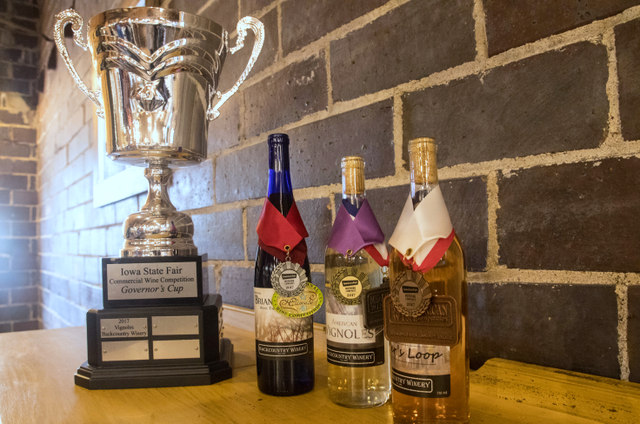
When the Gables competed in the commercial wine competition at the 2017 Iowa State Fair, the judges selected Vignoles from Backcountry Winery for the top honor, the Governor’s Cup. Vignoles is a semi-dry white wine that boasts crisp flavors of tropical and citrus fruits and a clean finish.
Iowa’s Wine Industry, By the Numbers
Data from the Iowa Wine Growers Association (IWGA) shows that Iowa has:
• 103 wineries
• 267 vineyards
• 1,300 acres of grapes
• 8 wine trails
• 40+ cold-climate grapes grown
• $420 million of economic impact in 2012
• 2,600 full-time jobs
• 358,000 wine related tourists per year
On average, the typical Iowa winery produces approximately 3,000 gallons of wine annually. The Iowa native wine industry helps promote and establish additional activity in the state, including lodging, food, travel, gifts, agri-tourism, event centers, festivals, music, art and a host of service industries.
“By our estimation, based on direct feedback from the wineries we surveyed, there was over $2.1 million in revenue generated from these wine-related events and facilities,” according to the 2012 “Economic Impact of Iowa Wine and Wine Grapes” report produced by Frank, Rimerman + Co, LLP.
In order for the industry to keep growing and attracting new visitors, wineries not only need to continue focusing on improving wine quality, but consider expanding into more wine-related events like private parties, weddings and festivals held on winery properties, according to the report.
- I originally wrote this story for the Progress section of Farm News, Ft. Dodge, Iowa in February 2018.
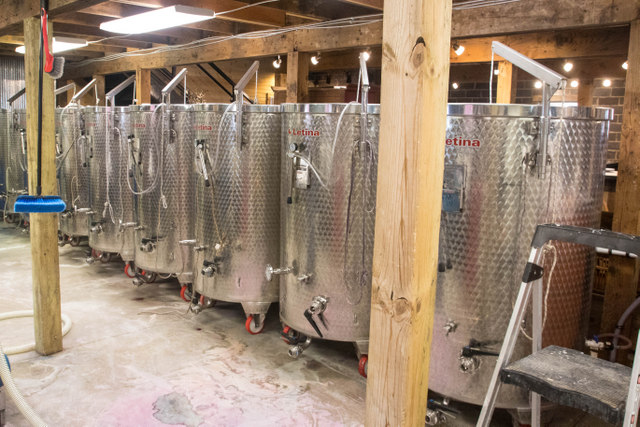
Backcountry Winery’s fermenting equipment is housed in a Hamilton County, Iowa, barn that’s approximately 100 years old.
Want more?
Thanks for stopping by. I invite you to read more of my blog posts if you value intriguing Iowa stories and history, along with Iowa food, agriculture updates, recipes and tips to make you a better communicator.
If you like what you see and want to be notified when I post new stories, be sure to click on the “subscribe to blog updates/newsletter” button at the top of this page, or click here. Feel free to share this with friends and colleagues who might be interested, too.
Also, if you or someone you know could use my writing services (I’m not only Iowa’s storyteller, but a professionally-trained journalist with 20 years of experience), let’s talk. I work with businesses and organizations within Iowa and across the country to unleash the power of great storytelling to define their brand and connect with their audience through clear, compelling blog posts, articles, news releases, feature stories, newsletter articles, social media, video scripts, and photography. Learn more at www.darcymaulsby.com, or e-mail me at yettergirl@yahoo.com.
If you’re hungry for more stories of Iowa history, check out my top-selling “Culinary History of Iowa: Sweet Corn, Pork Tenderloins, Maid-Rites and More” book from The History Press. Also take a look at my latest book, “Dallas County,” and my Calhoun County” book from Arcadia Publishing. Both are filled with vintage photos and compelling stories that showcase he history of small-town and rural Iowa. Order your signed copies today! Iowa postcards are available in my online store, too.
Let’s stay in touch. I’m at darcy@darcymaulsby.com, and yettergirl@yahoo.com.
Talk to you soon!
Darcy
@Copyright 2018 Darcy Maulsby & Co. Blog posts may only be reprinted with permission from Darcy Maulsby.

Recalling a Most Unconventional—and Life-Changing–FFA Journey
My FFA story is so unlikely that even I can’t quite believe it myself. It all began in the fall of 1989, when I was starting my sophomore year at Southern Cal High School in Lake City.
As a child of a Farm Crisis, I never thought about joining FFA. I was busy with classes, band, choir, theater and other activities, and the unspoken message was clear—ag has no future, so don’t spend your time there. Then along came Ed Ricks.
Ed was Southern Cal’s ag teacher and FFA advisor. Turns out he was also a talent recruiter. He asked me whether I’d be interested in coming over to the ag building and studying ag rather than taking the standard 10th grade biology class. I was intrigued. Ed worked out an arrangement with the biology teacher so I could skip biology class every day and instead focus on ag, as long as I could pass the biology tests.
No problem.
What a golden opportunity this turned out to be. I discovered a whole new world of learning, plus I didn’t have to be bored in a biology class. (And yes, I always passed the tests.)
I’m forever grateful that Ed welcomed me into the dynamic world of FFA. Not only did I love the ag classes, but it was fun to compete on the horticulture/floriculture team at nationals in Kansas City. My ag adventures truly set me a path that has defined my career for more than 20 years. They also explain why I’m sure a big believer in FFA.
As I look back, it’s amazing to think how much FFA has changed, and what hasn’t changed, since those days.
1. More diversity. When I was in FFA, there were usually only three to five girls at most in our chapter. That era wasn’t that far removed from the days when girls were not allowed to join FFA (a change that didn’t come until 1969.) Now girls often outnumber boys in many FFA chapters. I was excited that our local South Central Calhoun FFA chapter offered a Diversity in Ag class for the first time this fall, thanks to advisor Matt Carlson, to help girls learn more about the diverse career options available in ag today.
2. Ability to inspire. As I worked with the Diversity in Ag students, I remembered just how influential adults can be at this point in an FFA student’s life, and how much we can inspire the next generation of ag leaders, if we only take the time.
3. Learning made fun. While “fun” doesn’t come to mind when I think of most of my high school classes, it’s a word I’ve always associated with ag education. That all stems from my positive experiences in FFA, from working in our greenhouse to competing with teams that traveled from Ames to Des Moines to Kansas City.
4. Competition. Speaking of competition, I grew up in the era before everyone got a participation ribbon, and it made all the difference in my outlook on life. I loved competing on our floriculture/horticulture team. Even when I didn’t do well in certain categories likes salesmanship, I learned how to keep trying, keep learning and keep progressing. I also come from a legacy of FFA competitors. My Uncle Jack Dougherty competed in public speaking at the state FFA convention in Des Moines in 1956, where he focused on soil conservation. My family still quotes his words that “when the soil is gone, so are we.”
5. Real-world connections. These FFA lessons, from soil conservation to sales and communication skills, aren’t just academic theory. They have real-world applications that continue to influence my approach to business, farming and life.
6. Broadening your horizons. Being recruiting into FFA opened up a whole new world of career options I might never have considered. While there isn’t an abundance of children of the 1980s Farm Crisis working in agriculture, I consider myself to be one of the fortunate ones, all because Ed Ricks helped me broaden my horizons.
7. Useful knowledge you don’t learn anywhere else. When I’m at a meeting, I can tell who’s an FFA alum and who’s not, simply by whether a person knows how to conduct a meeting properly with parliamentary procedure. This is such a useful skill, and it’s curious to me that FFA is one of the few organizations that seems to understand its value.
8. Giving back. I remember helping plant and water the flowers in the planters around Lake City’s town square as part of our FFA training. While I just thought this was a fun way to get away from school for awhile, lessons like this helped plant the seed of community service in my life.
9. Leadership. As I volunteer with local FFA chapters today, I’m always inspired by the leadership opportunities that kids embrace at the chapter, district, state and even national levels. A dedicated FFA member always stands out among his or her peers. Some of FFA’s most notable alums have ascended to the highest levels of their chosen professions, from President Jimmy Carter to professional athletes like Bo Jackson to country music superstars Tim McGraw and Taylor Swift.
10. Focus on the future. As I look back, I knew I had a good thing going in high school with FFA, but I wish would have understood even better the amazing opportunities I had. It says a lot about an organization when you realize more of its value the longer you’ve been away from it.
It’s always interesting to me that FFA took root in the mid-1920s to counter the trend of boys losing interest in agriculture and leaving the farm. I think of my own FFA story and am still inspired by the wisdom reflected in the the FFA creed:
“I believe in the future of agriculture, with a faith born not of words but of deeds – achievements won by the present and past generations of agriculturists; in the promise of better days through better ways, even as the better things we now enjoy have come to us from the struggles of former years.”
Long live FFA!
P.S. Thanks for joining me. I’m glad you’re here.
Want more?
Thanks for stopping by. I invite you to read more of my blog posts if you value intriguing Iowa stories and history, along with Iowa food, agriculture updates, recipes and tips to make you a better communicator.
If you like what you see and want to be notified when I post new stories, be sure to click on the “subscribe to blog updates/newsletter” button at the top of this page, or click here. Feel free to share this with friends and colleagues who might be interested, too.
Also, if you or someone you know could use my writing services (I’m not only Iowa’s storyteller, but a professionally-trained journalist with 20 years of experience), let’s talk. I work with businesses and organizations within Iowa and across the country to unleash the power of great storytelling to define their brand and connect with their audience through clear, compelling blog posts, articles, news releases, feature stories, newsletter articles, social media, video scripts, and photography. Learn more at www.darcymaulsby.com, or e-mail me at yettergirl@yahoo.com.
If you’re hungry for more stories of Iowa history, check out my top-selling “Culinary History of Iowa: Sweet Corn, Pork Tenderloins, Maid-Rites and More” book from The History Press. Also take a look at my latest book, “Dallas County,” and my Calhoun County” book from Arcadia Publishing. Both are filled with vintage photos and compelling stories that showcase he history of small-town and rural Iowa. Order your signed copies today! Iowa postcards are available in my online store, too.
Let’s stay in touch. I’m at darcy@darcymaulsby.com, and yettergirl@yahoo.com.
Talk to you soon!
Darcy
@Copyright 2018 Darcy Maulsby & Co. Blog posts may only be reprinted with permission from Darcy Maulsby.

Soy Power Shines at Historic Rainbow Bridge
I was furious the minute I saw it. Blue spray paint defaced the bronze historical marker attached to a large stone south of Lake City near Rainbow Bridge, a favorite destination where I take my dad, mom and trusty red heeler, Maggie, for Sunday drives.
I snapped a photo of the crude star scrawled across the marker in mid-August and posted it on social media to express my disgust. While outraged Facebook friends posted hundreds of comments lamenting the vandalism, few solutions emerged.
I’m no graffiti removal expert and didn’t know what to do next, so I turned to Google. My search led me to Natural Soy Products’ graffiti remover. Not only did the product promise to remove paint, but this eco-friendly solution is made from American-grown soybeans. When I found out the company is based in Brooklyn, Iowa, I was sold and ordered two bottles of Graffiti Remover.
I was still nervous, though. Was I doing the right thing?
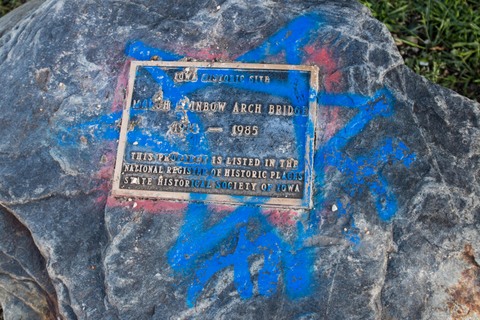
Look at this mess defacing this bronze marker that denotes the history of Rainbow Bridge. What a mess!
Rainbow Bridge spans generations of history
Iconic Rainbow Bridge has spanned the Raccoon River for more than a century southwest of Lake City and is an outstanding example of Iowa engineer James B. Marsh’s rainbow arch design. Hundreds of bridges with this distinctive “rainbow” profile were constructed in the 1910s and 1920s, mainly in the Midwest, though few remain.
Despite its storied history, the local Rainbow Bridge has long been a target for graffiti. Still, I kept thinking this latest act of vandalism had gone too far. I didn’t want to inflict more damage, though, in my attempt to clean up the mess.
Putting soy power to work
When my bottles of Graffiti Remover arrived, I rounded up a vegetable scrub brush, some rags, fresh water and my dog. We headed out to Rainbow Bridge late that afternoon to get to work.
While the Graffiti Remover label recommended waiting at least 10 minutes after spraying the cleaner, impatience got the best of me. I tried scrubbing off the paint after several minutes and was delighted to see promising results. In less than 15 minutes, I cleaned the entire marker and stone.
Always curious, I wanted to learn more. “Our products utilize the powerful, natural properties of soy,” said Joe Barber, president and CEO of Natural Soy Products, who responded to my inquiry. He added that soybean oil and soy methyl esters can be processed into a variety of useful products, from household cleaners to industrial applications.
Many of these products have evolved from innovations in the soy biodiesel industry. It’s exciting to see soy-based technology not only protecting history at Rainbow Bridge, but creating new solutions that will benefit our families and communities for generations to come.
(I first shared this story on my Facebook page in an abbreviated form. Ann Clinton, editor of the Iowa Soybean Review magazine, asked me to write the story for the Iowa Soybean Association‘s magazine. I was happy to oblige, and the piece you just read here appeared in the November 2017 issue. But wait–there’s more! I also wrote a different version of the story for Farm News‘ annual soybean section in the fall of 2017. Here’s the story below.)
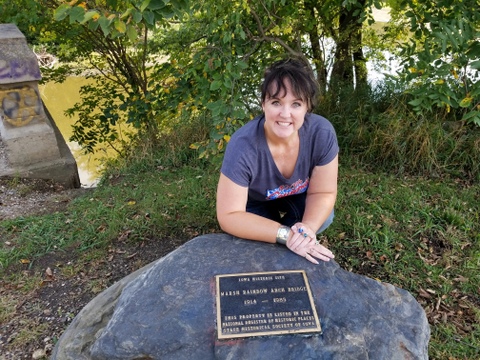
Amazing what a non-toxic soy-based cleaner and a little elbow grease can do. The graffiti remover started dissolving the paint in minutes.
Cleaning Up with Soy Power: Iowa Company Redefines Eco-Friendly Cleaning Solutions
Environmentally-friendly cleaning products often make big promises, but the results don’t always live up the hype—unless soybeans are involved.
“Soy works great for cleaning products, lubricants and more,” said Craig Lang, former Iowa Farm Bureau Federation president and a farmer from Brooklyn, Iowa. “These products have come about because of innovations in the soy biodiesel industry.”
Soy-based cleaners and other soy-based products are a specialty of Natural Soy Products in Brooklyn, which uses soy oil and soy methyl esters to produce a wide array of consumer and industrial products. “I’ve seen some really amazing things with these bio-based products,” said Lang, who has worked with Natural Soy for almost three years. “They are highly effectively.”
The Graffiti Cleaner, for example, is used by customers from California to Chicago and beyond. Soy-based products like this not only clean up messes, but they can help protect water quality.
“Water quality is an issue that needs to be at the forefront,” said Joe Barber, president and CEO of Natural Soy Products LDT, a division of the Clean Environment Company. “A lot of chemicals get put down drains every day. Environmentally-friendly, soy-based cleaning products offer an alternative and can be part of the solution to improving water quality.”
Growing new opportunities in Iowa
Established in 2013, Natural Soy Products is owned by Ken Budke, a U.S. Army veteran and retired Cedar Falls dentist from Cedar Falls who’s an entrepreneur at heart. When Budke saw the potential of soy-based solutions for home and industrial use, he knew he was on to something, Barber said.
“Our products work, because they utilize the powerful, natural properties of soy,” Barber said. “Soybean oil and soy methyl esters can be processed into many different products that benefit consumers and local soybean farmers.”
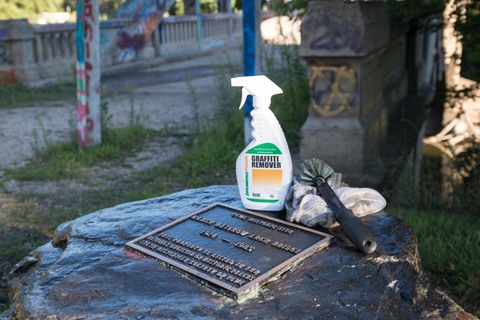
Here’s the soy-based graffiti remover I bought from Natural Soy in Iowa. It worked like a charm.
Household cleaning products from Natural Soy Products and the Clean Environment Company range from barbecue grill cleaner to hand degreasers to pet shampoo, along with toilet bowl cleaners and bathroom cleaners that make lime removal simple.
“Just because these are environmentally-friendly products doesn’t mean they don’t work,” said Barber, who noted that Natural Soy Products work well at home and in hospitals, nursing homes, businesses and more. “They are tough enough to get the job done, but gentle enough that you can get the product on your skin and it won’t cause any harm.”
Other soy-based products from the company are geared towards industrial use and perform well in harsh, dirty environments, Barber said. Lubricant sticks for the railroad industry are designed to protect the wheel/rail interface. These soy-based sticks offer higher lubricity than the traditional petroleum-based lubricants, providing greater maintenance and replacement cost savings. The solid material also provides a targeted application that greatly reduces maintenance costs.
Other soy-based industrial products from the company include an asphalt release concentrate that prevents asphalt from adhering to the bodies of dump trucks. A concrete sealer from Natural Soy Products includes a common ingredient that adds a plastic component to make this product even more effective.
“We have the ability to recycle Styrofoam and dissolve it into the soy blend,” Barber said. “If anything is spilled on top of the sealed concrete, this makes it easy clean up the mess.”
Iowa’s best-kept soy secret
Many of these innovative products were showcased in late August when Natural Soy Products welcomed guests from Expedition Farm Country 2017, a two-day bus tour of eastern Iowa ag hosted by the Iowa Food & Family Project.
“Natural Soy Products has to be one of Iowa’s best kept secrets,” said Shannon Latham, vice president of Latham High-Tech Seeds, which helped sponsor Expedition Farm Country to help urban consumers learn about Iowa agriculture. “What impresses me most is these products are industrial-strength, effective cleaners and lubricants, yet they’re safe for the environment.”
Latham also appreciates that Natural Soy Products is owned by a veteran, led by farmers and committed to supporting youth organizations like 4-H and FFA.
As Expedition Farm Country guests learned, a majority of Natural Soy Products’ production is located in the east-central Iowa town of Brooklyn, where the company has two locations. The company also has an office in Waterloo in the Cedar Valley TechWorks campus. The company employs about 10 people and is always looking for growth opportunities.
“Since we’re a small company, it can be challenging to compete with big corporations,” Barber said. “We’re identifying new ways to expand our distributor network and retail presence, though, while offering our products at a competitive price.”
While Natural Soy Products is based in Iowa, many of the companies’ products, especially the eco-friendly household cleaners, have found some of the most receptive markets far from the Midwest. Home cleaning products from the Clean Environment Company, for example, are popular on the East Coast and West Coast, while Natural Soy Products items have seen the most demand from the Rockies to the Ohio/Indiana region.
“While the majority of our sales are outside Iowa, we’re trying to change this,” Barber said.
Some of the company’s products can be found at Brothers Market in Parkersburg, for example. As more people hear about the benefits of home-grown soy solutions, the message is resonating with people, said Barber, who welcomes new inquiries from retailers wanting to carry items from Natural Soy Products and the Clean Environment Company.
“We need to make decisions today that will benefit our children and our children’s children,” Barber said. “Agriculture and soy products can be a big part of this.”
What are your best cleaning tips?
So I’m curious–do you have any favorite cleaning products or eco-friendly cleaning tips? If you do, feel free to leave a comment. I’d love to hear from you.
Here’s one of mine for cleaning those awful burned-on kitchen messes that happen sometimes, even to the best cooks:
Want more?
Thanks for stopping by. I invite you to read more of my blog posts if you value intriguing Iowa stories and history, along with Iowa food, agriculture updates, recipes and tips to make you a better communicator.
If you like what you see and want to be notified when I post new stories, be sure to click on the “subscribe to blog updates/newsletter” button at the top of this page. Feel free to share this information with friends and colleagues who might be interested, too.Also, if you or someone you know could use my writing services (I’m not only Iowa’s storyteller, but a professionally-trained journalist with 20 years of experience), let’s talk. I work with businesses and organizations within Iowa and across the country to unleash the power of great storytelling to define their brand and connect with their audience through clear, compelling blog posts, articles, news releases, feature stories, newsletter articles, social media, video scripts, and photography. Learn more at www.darcymaulsby.com, or e-mail me at yettergirl@yahoo.com.
Talk to you soon!
Darcy
P.S. Thanks for joining me. I’m glad you’re here.
Copyright 2017, Darcy Maulsby & Co.
